▲오동도를 끼고 있는 아름다운 여수
조순익
자산공원은 말이야, 여수에서 전망 좋기로 이름난 곳이야. 여수를 상징하는 돌산대교도 한눈에 들어오고, 우리가 오늘 여행할 오동도도 훤하게 보이지. 그런데 왜, 섬 이름이 오동도냐고? 그래. 오동잎을 닮았다고 해서 오동도라고 하였대. 가만히 봐. 섬이 정말 오동잎처럼 생기지 않았어?
(Jasan Park is famous for its view in Yeosu. We can easily see the Dolsan Bridge, which symbolizes Yeosu, and also look toward Odongdo, our destination. Do you wonder why the island's name is Odongdo? Right, Odongdo was named after paulownia flowers(in Korean, it's Odong.) because the island looks like paulownia's leaf. Compose yourself to it and take a close look at it. Doesn't the island look just like leaf of a paulownia flower?)아, '섬'이라고 하는데 '섬'이 아닌 것 같다고? 그러게. 육지로 연결되어 있으니 섬이라고 하기, 좀 그러네. 하지만 오동도는 원래 섬이었어. 그런데 아주 오래 전에 방파제를 쌓아 육지와 이어 놓았지. 방파제는 그 길이만도 모두 1,213m나 된대. 동방파제가 445m이고, 서방파제가 768m이니 상당하지.
(Oh, you may be curious about why it's called an island, since it's connected with land. Odongdo was actually an island, but our ancestors built a seawall long time ago and linked it with land. The seawall is so long as 1.2km! The east seawall is 445m, and the west is 768m. So longer than expected, isn't it?)그런데 무슨 책을 들고 있냐고? 응, 에리히 프롬의 ≪소유냐 존재냐≫라는 책이야. 이 책에 있는 시를 들려주고 싶어서 가지고 왔어. 웬 시? 그래. 일단 들어 봐.
(Do you wonder which book it is? This is "T0 HAVE OR TO BE" written by Erich Fromm. We brought it to appreciate a poem with you. Which poem? Okay, we will recite, so please listen carefully.) 눈여겨 살펴보니
울타리 곁에 냉이꽃이 피어 있는 것이 보이누나!
(Looking carefully, It seems that shepherd's purses are blooming near the fence!)잘 들었어? 이 시는 일본 시인 마쓰오 바쇼의 시인데, 뭔가 떠오르는 게 있어? 고개를 갸우뚱하는 걸 보니 잘 모르겠다는 표정이군. 그럼, 시 한 편을 더 들려 줄게. 이 시는 영국의 시인 테니슨의 작품이야.
(Can you feel it? This poem was written by Matsuo Bashou, a Japanese poet. Do you have anything coming to your mind? With a tilt of your head, it looks like you don't understand well. Then we'll tell you another poem. This is a poem written by Tennyson, an English poet.) 갈라진 벽 틈새에 핀 꽃이여,
나는 너를 그 틈새에서 뽑아내어,
지금 뿌리째로 손 안에 들고 있다.
작은 꽃이여― 그러나 만약 내가
뿌리째 너를, 너의 모든 것을 알 수 있다면,
신과 인간이 무엇인지도 알 수 있으련만.
(Flower in the crannied wall, I pluck you out of the crannies; Hold you here, root and all, in my hand, Little flower - but if I could understand What you are, root and all, and all in all, I should know what God and man is.)두 시가 어떻게 다른지 알겠어? 잘 모르겠다고? 그럼 우리가 알려 줄게. 두 시는 모두 산책길에서 본 꽃을 보고 노래하고 있어. 하지만 바쇼는 꽃을 보기만 하는데, 테니슨은 꽃을 뿌리째 뽑아 버렸지.
(Can you see the difference between them? Don't know? Then we can tell you. Both of them are telling about the beauty of a flower on a walk. However, Tennyson rooted out the flower while Bashou was just looking at it.)이를 에리히 프롬은 어떻게 해석한지 알아? 바쇼는 아름다운 자연을 존재 자체로 바라보기만 하는데, 테니슨은 자연을 자기 마음대로 소유하려 한 거래.
(Do you know how Fromm interpreted this? He said that Bashou just wanted to watch the nature as it was, and Tennyson tried to possess the nature for his own.)그러고 보니, 이제 뭔가 알겠다는 눈치군. 아름다운 자연을 있는 그대로 '보존'하려는 사람이 있는가 하면, 닥치는 대로 '개발'하여 자기 잇속만을 챙기려는 사람들이 있으니까.
(Now you've got it! Some people want to 'conserve' the beautiful nature as it is, and others try to 'develop' it to gain their own profit.)하지만 걱정하지 마. 우리 여수 사람들은 오동도를 '바쇼'처럼 바라만 보지도 않았지만, 그렇다고 '테니슨'처럼 뿌리째 뽑아 버리지도 않았어. 그럼 어떻게 대했느냐고?
(But never worry! The people of Yeosu didn't choose any of them. We did not root out the nature like Tennyson, but we did something other than just looking around. Then how do we treat it?) 나 홀로
숲속을 거닐었지.
아무것도
찾을 뜻은 없었네.
그런데 그늘 속에 피어 있는
작은 꽃 한 송이 보았지.
별처럼 반짝이고
눈망울처럼 예쁜 꽃을.
그 꽃을 꺾고 싶었는데,
꽃이 애처롭게 말했네.
내가 꺾여서
시들어 버려야 되겠어요?
하여, 꽃을 고스란히
뿌리째로 캐어,
예쁜 집 뜨락으로
옮겨왔지.
조용한 자리에
다시 심어 놓으니,
이제 늘상 가지 치고
꽃 피어 시들 줄 모르네.
(I was walking in the woods Just on a whim of mine, And seeking nothing, That was my intention. In the shade I saw A little flower standing Like stars glittering Like beautiful little eyes. I wanted to pick it When it said delicately: Should I just to wilt Be picked? I dug it out with all Its little roots. To the garden I carried it By the lovely house. And replanted it In this quiet spot; Now it keeps branching out And blossoms ever forth.)이 시는 괴테의 시야. 여기서 괴테도 산책길에서 본 꽃을 이야기하고 있지. 하지만 괴테는 바쇼처럼 보고 있지만도 않고, 테니슨처럼 꽃을 꺾지도 않았어. 꽃을 뽑아 뜨락으로 옮겨 심었지. 그런데 말이야, 우리 여수 사람들이 오동도를 인간의 삶에 불러들이는 방식이, '괴테'와 매우 닮았어.
(This is a poem written by Goethe, he was also telling about a flower he saw while taking a walk. Goethe neither looked on it like Bashou, nor rooted it out like Tennyson. He picked up the flower and transplant it into his garden. And, Yeosu people have adored Odongdo just as he did.)물론 그냥 보고만 있는 '바쇼'가 되면 오죽 좋겠어? 하지만 자연을 그대로 두고 보는 것은 현실적으로 어렵잖아. 그렇다고 꺾어놓고 죽어가는 꽃을 보고 있는 '테니슨'이 되어서는 안 되겠고. 그래서 우리는 '괴테'처럼 오동도라는 꽃을 '시들지 않게' 인간에게 옮겨 심으려고 애써 왔어.
(Of course, just like in Bashou's way, conserving nature as it is, is the best, but it's hard to do so in the real world. Also, we can't choose the way of Tennyson's rooting out the flower and seeing it dying. So, we took Goethe's way and tried to transplant a flower named Odongdo to the view of humans 'without wilting'.)오늘은 그것을 우리 친구들에게 보여 주려고 떠나는 여행인데, 어때? 재밌겠지?
(Today, we take a trip for you to look at that. How is it? Does it seem interesting?)

▲오동도의 옛날 모습
김성환
오동도의 옛 모습이야. 지금하고 많이 다르지? 옛날 오동도는 이처럼 사이사이에 막대를 꼽아 두었어. 저 막대가 어디에 쓰이는 거냐고? 사진을 자세히 봐. 파도가 엄청 무섭게 치지? 저 막대는 거친 파도에 휩쓸리지 말라고 설치해 놓은 거야. 파도가 칠 때는 막대를 꼭 잡고 있다가, 파도가 잠잠할 때 뛰어서 다음 막대를 잡으며 빠져나오란 거지. 위험해 보인다고? 그러게. 하지만 저 막대마저 없었을 때에는 오동도를 오가다가 목숨을 잃은 사람이 많았대.
(This is an old picture of Odongdo. It's a lot different from now. They had put sticks in from side to side. What were these used for? Look at the picture carefully. The waves rise high with lots of strength. The sticks were installed to prevent people from being swept away. Holding the stick while the waves were crashing in, and then jumping to the next stick while the waves were mild. It was so dangerous, but before they put in the sticks, a lot of people might have died when they went to visit Odongdo.)그래서 우리 조상들은 안전을 위해 방파제를 튼튼하게 만든 거야. 방파제는 너울을 막아 주고 해안이 침식되는 것도 막아 주거든. 현재는 막대를 모두 없애고 방파제를 쌓아서, 파도로 인해 일어나는 사고도 방지하고 있어. 이렇게 오동도는 과거와 많이 달라졌어. 하지만 우리 여수 사람들은 '괴테'처럼 '지속 가능한 오동도'를 만들기 위해 공을 들여왔어. 가 보면 실감하게 될 거야.
(So, our ancestors made a seawall more strongly for safety. The seawall breaks down the wave and prevents the shore from eroding. Recently, we removed all the sticks and built a new seawall to prevent lots of accidents by waves. Like this, Odongdo is very different from that of the past. But Yeosu citizens tried hard to make 'a sustainable Odongdo' just like Geothe's. Come, and feel it.)"'지속 가능한 여수엑스포'는 오동도에서 미리 느낄 수 있어."("You can feel 'The sustainable Yeosu Expo' on Odongdo.")
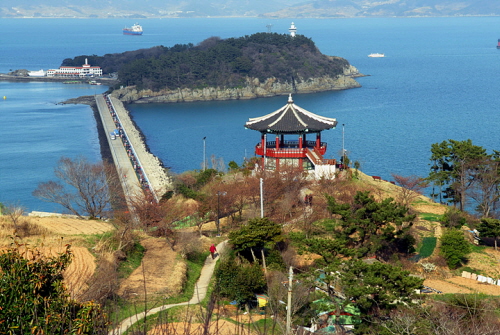
▲자산공원에서 오동도로 내려가는 길
김광중
자산공원에서 오동도로 가는 길은 멀지 않아. 자산공원에서 팔각정을 따라 샛길로 내려가다 보면 오동도로 바로 갈 수 있거든. 그런데 길이 가파르니까 조심해야 해. 천천히 가도 10분 정도면 갈 수 있으니 서두르지 마.
(Odongdo isn't far from Jasan Park. You can go straight to Odongdo walking along the side road next to the Palgakjeong. But watch out! This road is very steep! It won't take more than 10 minutes, so you don't need to hurry.)오동도 자랑 몇 가지 해볼까. 오동도는 말이야, 여수 동남쪽에 있는 섬이야. 섬 전체가 높이 100m 안팎의 완만한 구릉지를 이루고 있어.
(Let us introduce some features of Odongdo. It's on the southeastern side of Yeosu. Since it's approximately 100 meters high, the whole island looks like a small hill.)배를 타고 오동도를 둘러보면 소라바위도 있고, 병풍바위도 있고, 지붕바위도 있고, 코끼리바위도 있고. 또한 용굴과 온갖 모습의 기암절벽이 절경을 이루고 있어.
(When you look around the island on a boat, you can see Sorahbawie (a spiral shaped rock), Byeongpungbawie (a rock that looks like a folded sheet), Jibungbawie (a rack that looks like a rooftop), and Kokiribawie (an elephant shaped rock). Also, there's Yonggul (it means the dragon's cave) and all the figures of strange rocks and rugged cliffs with the beautiful scenery beyond.)그리고 날씨가 따뜻하고 비가 많은 덕분에 다양한 난대성 식물이 자생하고 있지. 동백나무, 신이대, 후박나무, 예덕나무, 광나무, 돈나무 등 총 193종의 수목이 자라고 있거든.
(Moreover, the weather is quite warm and it rains a lot in Odongdo, so there are various kinds of temperate, and plants such as camellia, sasa, magnolia, juglan, privet, and tobira can all grow wild. About 193 kinds of trees grow here.)그런데 혹시 해산물 좋아해? 오동도 주변에선 해삼, 멍게, 소라, 성게, 전복 등 다양한 해산물을 먹을 수 있어. 주머니가 좀 두둑하면 횟집에 가서 맛보아도 되겠지만, 차마 이 말은 못 하겠어. 에이, 괜히 먹는 얘기했네. 우리 친구들 주머니 사정 뻔히 알면서.
(By the way, do you like seafood? You can eat a large variety of seafoods around there including abalone, snapper, croaker, and sea urchin. It would be a great joy to visit a seafood restaurant if you can afford to, but we can't say like this. Oh, we talked about the food to no purpose. Even though, we know your pocketbook.)그래 다른 얘기할게. 오동도의 해안 경치는 정말 기가 막혀. 무엇보다 이른 아침에 일어나서 보는 해돋이 광경은 한 폭의 그림 같다니까. 그래서 1968년 대한민국 정부는 오동도 일대를 해상국립공원으로 지정하였어.
(Okay, we'll talk about different things. Shore of Odongdo commands so beautiful. Chief of all, the view of sunrise is beyond as beautiful as a portrait, so the Korean government designated the whole area as Oceanic National Park in 1968.)
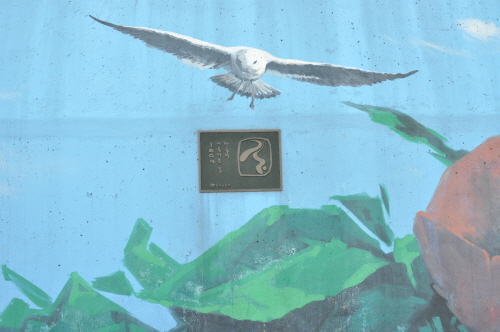
▲ '한국의 아름다운 길 100선' 표지판
손지성
짜잔, 드디어 오동도 입구에 이르렀네. 그런데 이게 무슨 안내판이냐고? 우리가 걷는 이 길이 '한국의 아름다운 길 100선'으로 선정되었다는 명패야. 2006년이었으니까, 몇 년 되었네. 건설교통부에서 우리나라 도로가 얼마나 아름다운가를 세계에 널리 알리고자 '아름다운 길'을 100개 골랐는데, 오동도 산책길도 그 안에 포함된 거지.
(Ta-dah! Now we can see the entrance of Odongdo. And what is this direction? This direction board shows that this road to Odongdo has been chosen as a 'Korea's most beautiful road top 100'. It was in 2006, so it has been years. The Ministry of Construction and Transportation chose 100 'beautiful roads' to inform people all over the world of the beauty of Korea's roads including Odongdo.)아 참, 오동도 가는 길로 들어서면, 유람선을 타라고 권하는 아저씨들의 목소리가 들려올 거야. 유람선만 있는 게 아니라 모터보트도 있으니까, 타 볼 만해. 하지만 오늘은 걸어가 볼까 해. 물론 동백열차를 타고 갈 수도 있지만, 걸어가면서 천천히 바다 냄새를 음미하는 것도 괜찮으니까.
(When you walk inside, you may hear men's voices suggesting to take a cruise. There are not only the cruises but also motorboats, which are good to ride. But today we are going to take a walk. Of course we can ride a sightseeing train called the 'Camellia train', but walking along the beach slowly and feeling the smell of sea is good, too.)
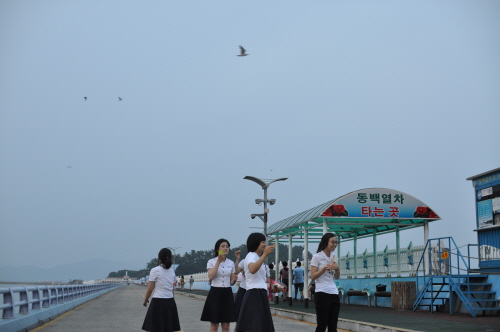
▲ 땅에는 우리 친구들, 하늘에는 갈매기, 그리고 그 사이를 이어주는 갈매기 모양의 가로등
오유선
갈매기 모양의 가로등이 예뻐 보이지? 사실, 갈매기는 여수를 상징하는 새야. 그래서 갈매기를 본떠서 가로등도 만든 거지.
(Oh, are you curious about the streetlights? In fact, the seagull symbolizes Yeosu, so the streetlights of Yeosu are modeled after it.)그런데 저기 좀 멀리 봐. 하늘 높이 날고 있는 갈매기가 보이지. 문득 미국의 작가 리처드 바크의 ≪갈매기의 꿈≫에 나오는 갈매기 이름 조나단 리빙스턴(Johnathan Livingston)이 떠오르지? "가장 높이 나는 새가 가장 멀리 본다"는 그 유명한 말과 함께. 자유의 참된 의미를 깨닫기 위해 하늘 높이 날던 갈매기였잖아. 그 갈매기는 우리더러 먹고사는 그런 삶에 머물러서는 안 된다는 메시지를 던져 주었지.
(And look at it in the distance. It seems that seagulls are flying high in the sky. What do seagulls remind you of? We think of "Johnathan Livingston Seagull" written by Richard Bark. Johnathan flew high above the sky to find out the true meaning of freedom, and made the famous quotation, "A bird that flies higher can see farther." He always teaches us a lesson; never be content with the food in front.)거울을 들여다보면 '초라한 나'의 모습이 보이지만, 아니야, 누구나 우리 내면에는 우리가 알지 못하는 '놀라운 가능성'이 감추어져 있어. 리빙스턴처럼. 우린 아직 젊잖아.
(When you look into the glass, you may find 'shabby me', but that's not the true you. Everyone has 'infinite potentials' inside, like Johnathan. We are young, and have infinite potentials!)
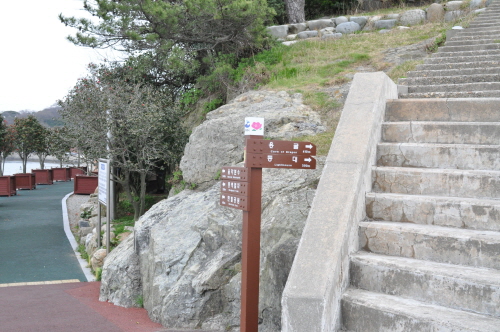
▲서방파제 끝의 갈림길
손지성
어디로 갈까? 오른쪽으로 갈까? 왼쪽으로 갈까? 아래로 갈까? 위로 갈까? 이쯤해서 미국의 시인 프로스트를 한번 떠올려 봐야겠네.
(Where shall we go now? Shall we go to the left or right? Under or upper way? It is time to remind ourselves of Frost, an American poet.) 노란 숲 속에 길이 두 갈래 갈라져 있었습니다.
안타깝게도 나는 두 길을 갈 수 없는
한 사람의 나그네라 오랫동안 서서
한 길이 덤불 속으로 꺾여 내려간 데까지
바라다 볼 수 있는 데까지 멀리 보았습니다.
그리고 똑같이 아름다운 다른 길을 택했습니다.
그럴 만한 이유가 있었습니다. 거기에는
풀이 더 우거지고 사람 걸은 자취가 적었습니다.
하지만 그 길을 걸으므로 해서
그 길도 거의 같아질 것입니다,
그 날 아침 두 길에는 낙엽을 밟은 자취 적어
아무에게도 더럽혀지지 않은 채 묻혀 있었습니다.
아, 나는 뒷날을 위해 한 길은 남겨 두었습니다.
길은 다른 길에 이어져 끝이 없으므로
내가 다시 여기 돌아올 것을 의심하면서.
훗날에 훗날에 나는 어디에선가
한숨을 쉬며 이 이야기를 할 것입니다.
숲 속에 두 갈래 길이 갈라져 있었다고,
나는 사람이 적게 간 길을 택하였다고,
그것으로 해서 모든 것이 달라졌더니라고.
(Two roads diverged in a yellow wood, And sorry I could not travel both And be one traveler, long I stood And looked down one as far as I could To where it bent in the undergrowth; Then took the other, as just as fair, And having perhaps the better claim Because it was grassy and wanted wear; Though as for that, the passing there Had worn them really about the same, And both that morning equally lay In leaves no step had trodden black. Oh, I kept the first for another day! Yet knowing how way leads on to way I doubted if I should ever come back. I shall be telling this with a sigh Somewhere ages and ages hence: Two roads diverged in a wood, and I, I took the one less traveled by, And that has made all the difference.)프로스트의 시 <가지 않은 길>에서도 화자가 망설이고 있어. "노란 숲 속에 길이 두 갈래로" 나 있기 때문에. 그래서 화자는 "안타깝게도 나는 두 길을 갈 수 없는/ 한 사람의 나그네라 오랫동안 서서/ 한 길이 덤불 속으로 꺾여 내려간 데까지/ 바라다 볼 수 있는 데까지 멀리 보았"지. 그러다가 그는 드디어 하나의 길을 선택했어. "풀이 더 우거지고 사람 걸은 자취가 적"은 길을 선택한 거야. 지름길이 아니라 에움길을, 사람들이 많이 다닌 직선의 길이 아니라 사람들의 발자취가 적은 곡선의 오솔길을 선택한 거지.
(In Frosts's poem, 'The Road not Taken', the narrator is hesitating because the road branches off into two in a yellow wood. So the narrator said "And sorry I could not travel both/ And be one traveler, long I stood/ And looked down one as far as I could/ To where it bent in the undergrowth" And then he choose one road. It was a grassy road that could be found no trace of people. It's not a shortcut but a roundabout way, also it's not a straight road traveled by many people but a curved road traveled by less people.)하지만 너무 안타까워하지 마. 우리 인류가 '개발의 길'과 '보존의 길'이 함께 만나는 '지속 가능한 개발의 길'을 찾아낸 것처럼, 오동도의 '윗길'과 '아랫길'은 다시 만나게 돼. '아랫길'은 이따 나올 때 걸을 수 있으니까, 우선은 '윗길'로 가 볼까? 숲길로 말이야.
(But you don't need to worry. These two roads in Odongdo eventually meet in the end, like we human beings will find that the 'way for development' and the 'way for preservation' meet together. Since the 'under way' can be traveled when we come out, let's take the 'upper way,' the way in the forest.)"사람은 자연과 어울려 살 수 있어, 오동도가 그걸 보여 주고 있어." ("Human and Nature can be together, Odongdo shows it.")

▲오동도 지도
여수지역사회연구소
오동도의 아름다움을 몸으로 느끼려거든 숲길을 걸어 봐야 해. 자, 숲속으로 가는 길이 어디에 있느냐고? 알면서. 방파제 길이 끝나는 곳에서 숲으로 향하는 새로운 길이 열려 있잖아. 세상 일이 모두 그런 것처럼, 길이 끝나는 곳에서 새로운 길은 시작되는 법.
(If you want to feel the beauty of Odongdo from the bottom of your heart, you have to walk through the woods. Do you wonder where the way to the forest is? You know. Where a road ends, another one begins. Just like all the other things, at the end of the seawall, there begins the wood.)그런데 가만, 어디서 향긋한 냄새가 나는 것 같지 않니? 코를 킁킁대며 벌름거렸더니, 길을 안내하던 박금희 해설가 선생님이 웃으면서 가르쳐 주셨어. 이게 바로 피톤치드의 향이라고. 피톤치드는 식물이 해충이나 곰팡이를 막으려고 스스로 내뿜는 물질이래. 그래서 오동도 숲을 걸으면 이 피톤치드 덕분에 스트레스도 해소되고, 심폐 기능도 좋아진대. 그야말로 일석이조지.
(And stop, do you smell something? When we tried to smell that, Park Guemhi, the guide teacher smiled and taught us that this is the smell of Phytoncide. Plants release Phytoncide to prevent harmful insects. So when walking through the Odongdo forest, Phytoncide helps release stress and strengthen our heart and lungs. That's like killing two birds with one stone.)
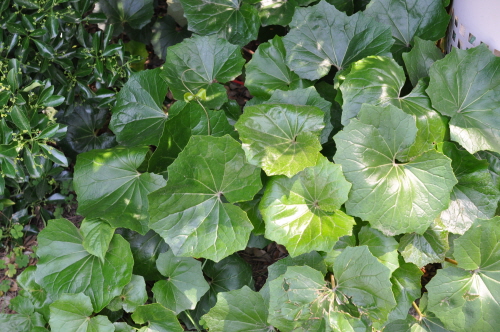
▲털머위
손지성
계단을 따라 올라가면 길옆에 넓적하게 생긴 잎을 볼 수 있어. 이게 뭔지 알아? 모른다고? 그래, 우리도 사실 몰랐어. 그냥 '이름 모를 풀' 정도로 생각했으니까? 조금 부끄럽긴 하네.
(While we went up the stairs, we found wide leaves. Do you know what it is? Yes, actually we didn't know either. We just thought that it's a kind of unknown grass. What a shame!)시인 안도현도 아마 우리와 같은 심정이었나 봐. 식물 이름 하나 모르고 시를 쓴다고, 스스로를 나무라고 있으니까. 안도현의 <애기똥풀>이라는 시를 들어 봐.
(Maybe the poet An Dohyeon had the same feeling as ours. He scolds himself since he has written poems not knowing any plants' name. Listen to the poem, 'Celandine' by An Dohyeon.) 나 서른다섯 될 때까지
애기똥풀 모르고 살았지요
해마다 어김없이 봄날 돌아올 때마다
그들은 내 얼굴 쳐다보았을 텐데요
코딱지 같은 어여쁜 꽃
다닥다닥 달고 있는 애기똥풀
얼마나 서운했을까요
애기똥풀도 모르는 것이 저기 걸어간다고
저런 것들이 인간의 마을에서 시를 쓴다고
(Until I become 35 years old, I have lived not knowing celandine Every year, when the spring comes back, They may look at my face. Celandine which hangs Pretty flowers like booger How did they feel sad? That the man who even do not know celandine is walking there That kind of man is writing poem in human's village)그러니 너무 부끄러워하지 마. 이게 바로 털머위인데 바닷가 근처에서 자라는 풀이래. 오동도에 지천으로 널려 있으니, 앞으로 길을 걷다 보면 자주 만날 수 있을 거야.
(So don't be ashamed. This is coltsfoot which grows at the seaside. There are lots of these in Odongdo, so we can frequently find coltsfoot while walking around.)
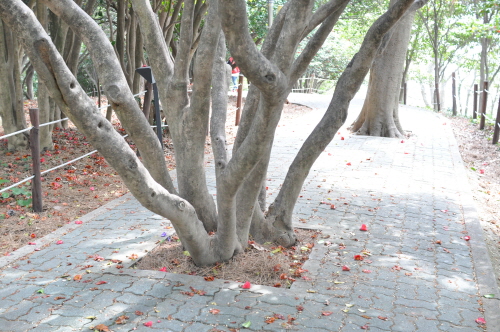
▲동백나무
손지성
길 가운데 있는 이 나무가 뭔지 알아? 밑에서 가지가 갈라져 나온 나무 말이야. 그래, 동백나무야. 이 나무는 우리가 사는 여수를 상징하는 나무지. 오동도에는 난대성 식물이 많이 자라고 있어. 그런데 그 중 동백나무가 제일 많대. 무려 3600그루가 넘는다니까.
(Do you know the tree located in the middle of the road? The tree with some branches spreading out from the trunk. Yes, this is a camellia. This stands for Yeosu where we live. Many temperate plants grow on Odongdo, and especially more than 3,600 camellia trees grows only on Odongdo.)
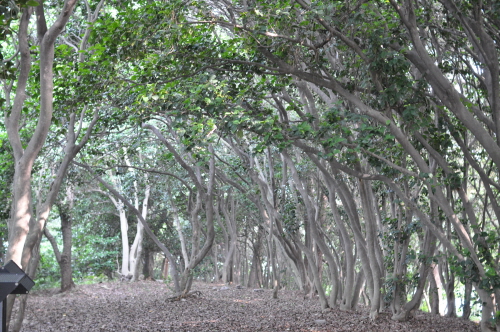
▲동백나무 숲
손지성
멋지지? 오동도는 이처럼 동백나무 숲으로 이름난 곳이야. 동백나무가 차나무과에 속하는 상록 교목이라는 것은 다들 알고 있을 거야. 그런데 오동도의 동백나무는 여느 동백나무와 조금 달라. 줄기 밑동에서 많은 가지들이 나와 관목처럼 자라고 있거든.
(Isn't it great? Like this, Odongdo is famous for its Camellia Forest. Maybe you all know that camellia belongs to tea family and is an evergreen forest tree. By the way, the camellia here is special. Unlike most species, it has a lot of branches on its trunk so that it looks like a shrub.)그러면 오동도의 동백나무에게 한번 다가가 볼까? 나무껍질은 회색빛이 도는 갈색이지? 안아 보면 정말 감촉이 좋아.
(Then how about taking a near view of a camellia in Odongdo? Its bark is grayish brown. It feels so good when we touch it.)그런데 동백나무 하면 빠뜨릴 수 없는 게 동백꽃이지. 우리 여수를 상징하는 꽃이 바로 동백꽃이거든. 겨울에 피어 봄까지, 그 붉은 꽃의 아름다움은 정말 황홀해.
(When we talk of the beauty of a camellia, we can't miss its flower, because it stands for Yeosu. From winter till spring, the beauty of that red flower is really fascinating.)그런데 동백꽃에서는 향기로운 꿀이 많이 나와. 그래서 동박새가 이것을 먹으면서 꽃가루받이가 일어난대. 서로 돕고 사는 자연의 모습을 느낄 수 있는 꽃이지. 동백꽃은 여수 사람들의 굳센 의지와 희생정신도 나타내지만, 서로 돕는 자연의 아름다움을 보여 주기도 해. 그래서 우리는 동백꽃을 여수를 상징하는 꽃으로 정했어.
(By the way, the camellia send out lots of fragrant honey. So a white-eye bird eats the camellia's honey, and helps the camellia pollinate. We can feel the nature that helps each other. The camellia embodies strong will, self sacrifice, and living in harmony. That's why they picked the camellia as the symbol of Yeosu.)
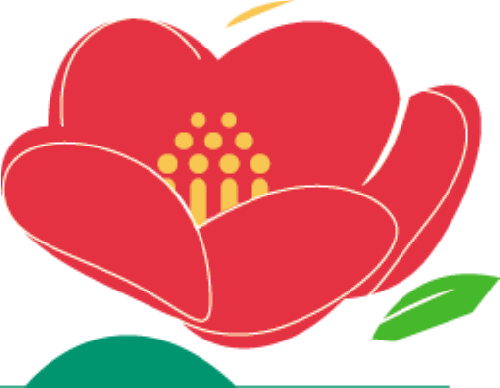
▲여수의 상징 동백꽃 캐릭터
여수시
이게 뭐냐고? 그래, 우리 여수의 캐릭터야. 동백꽃을 형상화한 건데, '화합'과 '단결'을 의미한대. 이번 엑스포도 화합과 단결의 축제가 되었으면 좋겠어. 우리 같이 "화합", "단결" 하고 외쳐 보자고!
(Do you wonder what it is? Right, this is the mascot of Yeosu. It is characterized as the camellia, and is a symbol of unity and harmony. Let us cheer saying "unity" and "harmony" hoping the Yeosu Expo will be a festival of unity and harmony.)재미있는 이야기 하나 해 줄까? 동백나무의 꽃은 몇 번 피는지 알아? 한 번 핀다고? 그래, 맞아. 하지만 여수 사람들은 세 번 핀다고들 해. 먼저는 나무에서 꽃이 피고, 다음으로는 꽃이 송이송이 뚝 떨어진 바닥에서 피고, 마지막으로는 바로 그것을 바라보는 우리의 마음에서 피어. 그래, 멋지지? 여수 사람들.
(We tell you interesting story. Do you know how many times the camellia blossoms? Once? Yes, right. But Yeosu people believe that they blossom three times. First it blooms on the tree, then it blooms during and after it scatters, and it blooms in the minds of those who look at it. It's quite nice, huh?)여수 사람들만 그런 게 아니라, 우리나라 사람들이 다 멋져. 우리나라에서는 대나무와 소나무, 매화나무를 세한삼우(歲寒三友)라 해. 겨울철에도 잎이 지지도 않고 푸름도 잃지 않아, 지조 높은 사람 같다고 하여 '벗'이라 불렀어. 그런데 말이야, 동백꽃도 세한지우(歲寒之友)라고들 해. 추운 겨울에도 정답게 만날 수 있는 친구라는 뜻이지.
(Not only Yeosu people but also all Koreans are nice. In Korea, people called bamboo, pinetree, and Japanese apricot the 'three friends of winter.' They are evergreen plants and keep their leaves alive in winter, so people spoke highly of their fidelity and called them 'friends.' We sometimes include camellia in these 'friends of winter.' It means they are good friends we can meet warmly even in the winter.)

▲팔손이
손지성
이게 팔손이야. 두릅나무과의 나무이지. 우리나라 남부 섬 지방이나 바닷가에 자생하는 식물인데, 직사광선에 잎이 상하므로 그늘진 곳에서 자란대. 키는 우와, 우리보다 크네.
(This is Aralia. It is a member of the Japanese angelica family. It lives in the southern islands of Korea or near the sea. And since its leaves are weak at direct sun light, it grows in the shade. It's even taller than us!)잎은 어긋나고 둥근 모양인데 잎몸이 7~9개로 크게 갈라져서 손바닥을 편 것 같아. 나무 이름도 흔히 잎이 여덟 갈래로 갈라져서 팔손이라고 지었대. 그런데 해설가 선생님이 잎이 여덟 개인 팔손이를 찾으면 그날 좋은 일이 생긴다고 해서 열심히 찾았는데, 무척 재밌었어.
(The leaves look like a hand faced palm up with the fingers spread, so it's called 'Palsoni(meaning eight fingers)' in Korean. Since the guide teacher said that one who finds Aralia with 8 fingers has good luck, we had the pleasure hunting time. It was so fun!)아, 그런데 팔손이 찾는다고 숲을 휘젓고 다니지 않았느냐고? 아냐, 그러진 않았어. 자연도 숨 쉬는 생명체라는 것쯤은 우리도 알거든. 이성부 시인이 쓴 <길 아닌 곳에 들다>라는 시를 들으면 정신이 번쩍 드는데, 뭐.
(Oh, but we didn't disturb the forest to find Aralia because we know nature is a breathing organism, too. The poem 'Get in which isn't the road' by a poet YI Seongbu sobers us.) 수북이 잠자는 낙엽들 뒤흔들어
깨워놓고 가는 내 발걸음 송구스럽다
놀라지들 말거라
나도 이파리 하나
슬픔을 아는 미물일 따름이니
(Shaking the sleeping leaves To wake them up, my step is sorry Don't be surprised I'm also a leaf And a small creature who knows sadness.)
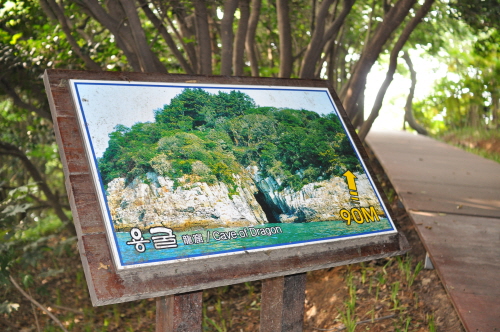
▲용굴 안내 표지판
손지성
팔손이 바로 옆으로 표지판이 보이지? 용굴로 가는 길을 안내해 주고 있어. 이 길을 따라 천천히 내려가 볼까?
(Can you see a direction board near Palsoni? This indicates a way to Yonggul. Let's go down along the street slowly.)
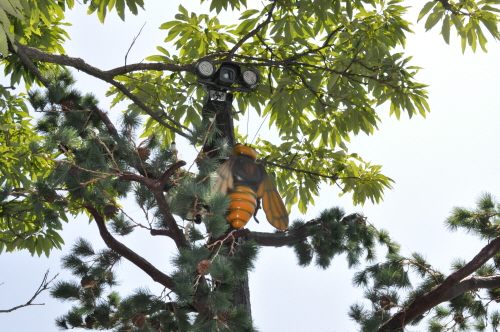
▲인공나무와 벌
손지성
계단을 내려가다 보면 이상한 나무 한 그루 볼 수 있을 거야. 나무처럼 만들어 놓은 나무야. 시시티브이(CCTV)를 살아 있는 나무에 설치하면 그 나무가 너무 아파하니까, 모형 나무를 만들어 설치한 거야. 자연과 인간이 더불어 살아가는 모습, '지속 가능한 여수'는 이렇게 곳곳에서 느낄 수 있어.
(You can find a strange tree while you walk through the stairs. It's a fake tree to install a CCTV and prevent any harm to other living trees. Nature and human beings can live together like this. Here we can feel 'Sustainable Yeosu'.)
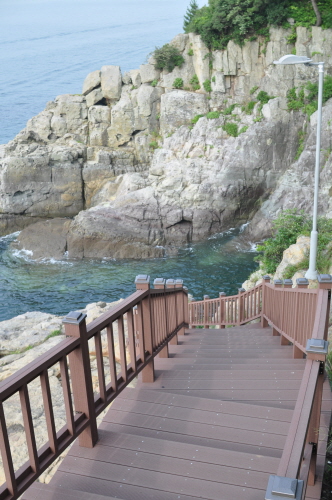
▲용굴로 내려가는 계단
손지성
계단을 다 내려오니까, 어때? 또 다른 세계에 온 것 같지 않아? 낚시를 하는 사람들의 모습도 보이고, 용굴을 보러 바위를 조심조심 내려가는 연인들의 모습도 눈에 들어 올 거야.
(When we reach the bottom, we feel like we have came to the wonderland. We can see people fishing, some couples walking down the rocks to see Yonggul.)용굴의 멋진 모습을 제대로 보고 싶다면 유람선을 타고 바다로 나와 보는 것도 좋은 방법이야. 배를 타고 오동도를 둘러보면 온갖 기암 절벽과 함께 이 용굴도 다 볼 수 있거든.
(If you want to see the view of Yonggul, it's a good idea to go aboard the cruise. You can take a look at the whole island and the cave by riding the cruise.)하지만 이곳은 그냥 서 있기만 해도, 기분이 날아갈 것 같아. 바닷바람이 시원하게 불어서, 온 몸이 다 상쾌해지는 것 같거든. 그 바람과 함께 들려오는 물소리는 우리 귀를 깨끗이 씻어 주기도 하지.
(Standing here is really good, too. Fresh air purifies us, we feel clean and clear. Also the sound of water washes our ears clearly.)
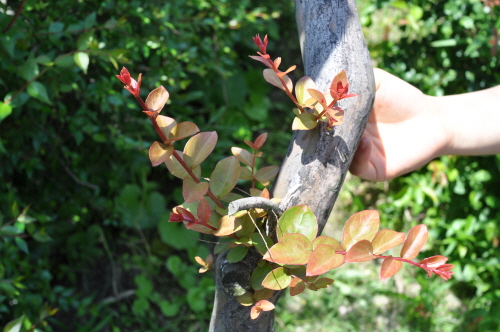
▲배롱나무
손지성
자, 이제 등대가 보이는 쪽으로 가 볼까? 아, 이 나무! '간지럼나무'야. 나무가 어떻게 간지럼을 타냐고? 거짓말 같다고? 아니야, 진짜야. 이 나무껍질을 손으로 살살 간지리면, 바람이 불지 않아도 나뭇잎이 움직여. 문득, 우리도 이 나무처럼 다른 이의 말과 행동에 간지럼을 타듯 반응하고 있지 않나 하는 생각이 들지 않아?
(Now, how about going to see the lighthouse? Oh, we found 'Tickle Tree'! Do you wonder how a tree can be tickled? Does it seem to be a lie? No, this is true. When we tickled the tree's bark, it flinched without a single blow of wind. Don't you feel that we respond to other's words and behaviors like the tree?)이 나무의 진짜 이름은 '배롱나무'지. 그런데 사람들은 이 나무를 '백일홍나무'라고 해. 하지만 '백일홍'은 실제로 배롱나무와는 달라. 백일홍은 국화과의 한해살이 풀이거든. 한마디로 백일홍은 배롱나무와는 전혀 다른 종이야.
(Its real name is crape myrtle, but some people mistake it with garden zinnia. The two plants is not the same. Since the zinnia is an annual plant, and is a totally different species from the crape myrtle.)하지만 우리는 이 나무를 그냥 '백일홍나무'라고 부르고 싶어. 이 나무는 실제로 꽃이 백일 동안이나 피어 있거든. 우리 선조들은 화무십일홍(花無十日紅)이라고 하여, 열흘 이상 빨갛게 피어 있는 꽃은 없다고 하셨어. 그런데 이 나무는 '화무십일홍'이란 말을 무색케 하며 한여름 동안 내내 피어 있어. 그래서 백일홍나무라고 그냥 부르고 싶다고 한 거야.
(But we want to call this a zinnia since it blooms its flower for 100 days. (In Korean 'zinnia' means to have been red for one hundred days.) Our ancestors used to say that there's not a single bud that can blossom more than ten days, but crape myrtle blossoms during the summer. That's why we want to call this zinnia.)그런데 말이야, 백일홍나무를 자세히 관찰해 보면, 하나의 꽃이 석 달 열흘 가는 것은 아니래. 계속 새로운 꽃망울이 피어나서, 나무 전체로 보면 여름 내내 꽃이 지지 않는 것처럼 보이는 거지.
(However, if we observe it carefully, we can find that it's not a flower that lasts for 3 months. Actually a new bud blossoms everyday, so it seems like a whole tree keeps blooming during the summer.)이 나무는 재질이 강하고 튼튼해서 세공의 재료로 많이 쓰인대. 그리고 그 꽃은 피를 멎게 하는 효능도 있고. 한방에서는 장염이나 설사 등을 잡는 데 약으로 쓰기도 한대. 무엇보다 이 나무 꽃은 진달래꽃과 함께 갓 시집 온 새댁들의 가슴을 설레게 하던 '화전놀이'의 주역이었어. 그래서인데 이 나무의 이름에 '아낌없이 주는 나무'라는 이름 하나를 더해야 할 것 같아.
(Crape myrtle was used to make things because the texture is hard and strong. According to Oriental medicine, the crape's flower stops bleeding, enteritis and diarrhea. Above all, this played a main role in 'Hwajeon play' which made a lady's heart flutter. So we think 'The tree that gives everything generously' should be added to its name.)"여수 사람들은 '사는 멋'을 알아. 어디 한 번 보여 줄까?"("Yeosu Citizens know how to lead a fancy life style. Do you want to see it?")
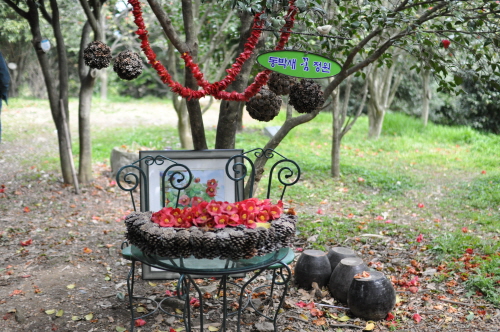
▲동백꽃차를 맛볼 수 있는 곳
손지성
여기가 어디냐고? 동백꽃차를 파는 곳이야. 동백꽃이 떨어질 때쯤, 꽃을 통째로 말려 보관했다가 차를 만들지. 동백꽃차는 달콤하면서도 쌉쌀한 맛이 나는데, 그 느낌이 참 오묘해. 피를 맑게 해 주고 몸속에 있던 노폐물을 배출해 주는 보약 같은 차라니까 꼭 맛보고 가. 오동도에만 있는 특허품이야. 아기자기하고 예쁜 소품으로 꾸며 놓은 동박새 정원에서 동백꽃차를 음미하는 운치, 그것 괜찮거든.
(Do you know where it is? This is the cafeteria where we can have camellia tea. When the flowers are about to fall, people dry that and later make tea. Camellia tea tastes sweet and bitter, which is quite racy. It cleans our blood and helps to extract our bodily waste like invigorant, so don't miss it! It's specialty in Odongdo. Having tea time in a charming garden is really romantic.)차 이야기가 나왔으니 하는 말인데, 동양 3국은 차를 참 즐겨. 그런데 단순히 차를 마시는 데 그치지 않고, 차에다 뭔가 조금씩 다른 의미를 담았어. 그래서 한국과 중국, 그리고 일본은 나라마다 차를 즐기는 방식이 다르지. 일본에서는 다도(茶道)라고 하고, 중국식 다예(茶藝)라고 하며, 한국에서는 다례(茶禮)라고 하는데, 이 말에서 알 수 있듯이 차를 대하는 태도에 차이가 있어.
(To speak of tea, far eastern Asians love to drink tea. Although they all love to drink tea, tea has different meanings on each country. Each country calls teatime in different ways; in Japan it's 'Dado(moral of drinking tea)', in China it's 'Daye(art of drinking tea)', and in Korea it's 'Darye(proprieties of drinking tea)'. Like this, there are differences in each country's attitude toward tea)우선 일본은 엄격한 절차와 격식을 바탕으로 정신 수양을 강조해. 그래서 오랜 시간 익혀야 할 정도로, 그 과정이 상당히 까다롭대. 이에 비해 중국은 차나무를 가꾸어 차를 만들고 찻물을 우려내는 즐거움과 함께 차 맛을 즐긴대. 이와는 달리 우리나라는 차를 차약[다약(茶藥)]이라 부를 만큼 차의 성분을 중요하게 여겨. 여기에 아주 간단한 예가 접목되어 있는 게, 우리나라의 차 마시는 법이야.
(First, Japan emphasizes procedure and formality. Therefore, they have very strict rules that they have to train for a long time. Drinking tea is a kind of mental discipline. In contrast, in China, they enjoy the pleasure of raising a tea tree, blending tea, and infusing tea. Chinese also enjoy the flavor. But Korea treated tea as a medicine. They payed attention to the materials inside the tea. Adding a simple polite manner to this is the way of having tea in our country.) 봄바람에 누대는 높기만 한데
차 내음 꽃향기와 섞이었구나
인간 세상 인연이 깨끗도 하여
소리마다 솔바람 노래 들리네
(Spring wind blows and a tower is high Fragrances from tea and flower are mixed Connection in the human world is so clean That I can hear the song of the wind in every sound)지금부터 150여 년 전에 살았던 조선의 선비 이유원의 시야. 그는 자신이 사는 집에 찻집을 만들어 놓고 차를 즐길 만큼 차를 좋아했어. 그래서 말인데, 동백꽃차도 이런 가벼운 마음으로 마시면 돼.
(This is a poem written by Yi Yuwon, a classical scholar in Joseon dynasty, who lived 150 years ago. He even made a tearoom in his house since he enjoyed tea very much. Like this, camellia tea can be enjoyed with a light heart.)오동도 곳곳에 자리 잡고 있는 신이대가 눈에 들어오지. 사전에는 '해장죽'이라고 나와 있는데, 우리가 사는 지방에서는 '신이대', '시누대' 등으로 불러. 임진왜란이 일어났을 때 이순신 장군이 이 신이대로 화살을 만들어 10만여 명의 왜군을 물리쳤다고 해. 그런데 요즘에는 이 신이대를 이용하여 돗자리, 죽부인을 만들어. 습기가 높은 여름에는 제격인 물건이지.
(You can find sasa all over Odongdo. Sasa is a kind of 'sea bamboo' according to the dictionary. It is said that Admiral Yi Sunsin made arrows with sasa and defeated the Japanese. Nowadays, sasa is used to make mats and cooling pillows. It is especially good in summer when the air is humid.)돗자리는 뭐고, 죽부인은 뭐냐고? 그래. 낯선 물건이니까, 설명을 해 줘야겠네. 돗자리는 대나무 줄기를 잘게 쪼개서 만든 자리야. 알겠지? 그리고 죽부인은 대오리로 길고 둥글게 얼기설기 엮어 만든 기구야. 여름밤에 서늘한 기운이 돌게 하기 위하여 끼고 자지. 그러니까 죽부인은 우리 선조들의 지혜가 담겨 있는 환경 친화적인 냉방 기구라고나 할까.
(Do you know what a mat and a cooling pillow is? They are unfamiliar, so we'll explain. A mat is a seat made by splitting a bamboo stem. A cooling pillow is a pillow made of sasa or bamboo, which collects and passes the wind that if we lay down and fall asleep while hugging it, we can defeat the hot summer night. It is an eco-friendly cooling system which contains our ancestor's wisdom.)
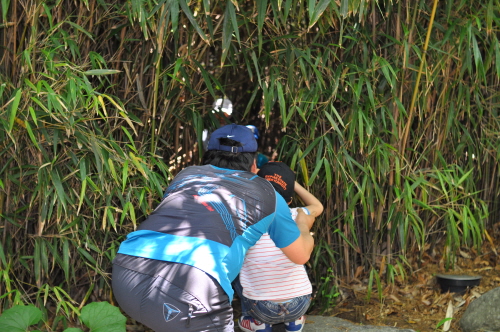
▲신이대숲과 가족
손지성
신이대가 만들어 놓은 자연 터널 사이에서, 기념 촬영하고 있는 가족이 있네. 즐거워 보이지? '가족'이라고 하면, 친구들은 어떤 생각이 나? 나라마다 가족이 갖는 의미는 다를 거야. 그런데 우리나라에서 가족은, 서로에게 존재의 이유야. 그만큼 끈끈해. 이정록 시인의 <의자>라는 시를 들어 보면 이해가 될 거야.
(We see a family taking pictures in the tunnel of sasa. They seem to be happy, don't they? When you think about 'family,' what occurs to your mind? Each country might have its own meaning. In Korea, sometimes family can be a reason for existence. You can understand this after listening a poem 'Chairs' written by Yi Jeongrok) 병원에 갈 채비를 하며
어머니께서
한 소식 던지신다
허리가 아프니까
세상이 다 의자로 보여야
꽃도 열매도, 그게 다
의자에 앉아 있는 것이여
주말엔
아버지 산소 좀 다녀와라
그래도 큰애 네가
아버지한테는 좋은 의자 아녔냐
이따가 침 맞고 와서는
참외밭에 지푸라기라도 깔고
호박에 똬리도 받쳐야겠다
그것들도 식군데 의자를 내줘야지
싸우지 말고 살아라
결혼하고 애 낳고 사는 게 별거냐
그늘 좋고 풍경 좋은 데다가
의자 몇 개 내놓는 거여
(Preparing for going to hospital, Mom throws her news. Since her waist hurts The whole world seems to be chairs Flowers, fruits, and they are all Sitting on the chairs On the weekend, Please visit your father's grave Cause you were a good chair For your father After getting acupuncture, We should lay straws on a melon field And support pumpkins with coils They will get chairs since they are also our family Please live without fighting. Are marrying and giving birth to babies matters? In good shadow and scenary, To give several chairs)그래. 우리에게 가족은 서로 의자가 되어 편안하게 내주는 거야. 가족이란 서로에게 비빌 언덕이 되어 준다는 뜻이지. 울고 싶을 때 내가 마음 놓고 울 수 있는 곳이 바로 가족이라는 울타리거든.
(That's right. To us, family is to become a chair for one another and give comfort and convenience. Family members become a sanctuary to each other and support each other. When we want to cry, where we could cry as much as we want in with family.)하지만 '가족'을 자기네 피붙이로만 한정하는 것은 문제가 있어. '이웃'도 가족처럼, '다른 나라 사람들'도 가족처럼, 아니 '이 세상 살아 있는 모든 것'을 가족처럼 대할 때, 이 사회도, 이 세계도, 이 지구라는 마을에도 참된 평화가 찾아올 것 같아.
(But we should not limit the border of 'family' to blood relationship. When we treat 'neighbors' as a family, 'foreigners' as a family, and 'all living things in the world' as a family, peace may come to this society, this world, and this global village.)왜 그렇게 생각하느냐고? 이 시에도 봐. 꽃도 열매도 다 의자에 앉아 있는 것이라는 표현에서, 참외와 호박에도 의자를 내주겠다고 다짐하는 표현에서, 그것을 읽어낼 수 있잖아.
(Do you wonder why? Look at the poem. We can read it in the expression that flowers and fruits are all sitting in the chairs or melons and pumpkins would get chairs.)그런데 또 갑자기 웬 책이냐고? 응, 우리를 지도하는 박용성 선생님이 엮으신 ≪이야기꽃≫이라는 책이야. 그 가운데 있는, 이야기 하나 들려 줄게. 참 재미있어.
(Do you know what the book is? Yes, this is a book "Story Flower" written by Park Yongseong who instructs us. Let us tell you one story among those stories. It's really interesting) 나무 아래에서 한 성인이, 진정한 사랑이 무엇인지 골똘히 생각하고 있었대. 그 때 아귀(배고픈 귀신)에게 쫓기던 비둘기 한 마리가 그의 품 안으로 도망쳐 들어온 거야. 성인은 비둘기를 감싸 안고 내놓지 않았지.
"난 배가 고파 미치겠소. 내 먹이를 빨리 내놓으시오."
아귀는 텅 빈 배를 가리키며 울부짖었대. 하지만 성인은 비둘기를 내줄 수 없었어.
"이 가련한 비둘기의 생명을 내팽개칠 수 없소. 차라리 비둘기 무게만큼 내 살점을 베어 가시오."
그러자 아귀는 양쪽에서 무게를 달 수 있는 양팔저울을 가져 왔대. 성인은 넓적다리 살점을 베어 올려놓았지. 한쪽엔 비둘기가, 다른 한쪽엔 살점이 올라간 저울은 비둘기 쪽으로 기울었어.
성인은 살점을 더 베어 냈어. 그래도 비둘기 쪽이 무거웠지. 분명 비둘기 무게 이상의 살을 떼어 냈는데도 저울은 비둘기 쪽으로 기운 거야.
그러자 성인은 벌떡 일어나 저울 위에 자신의 몸을 올려놓았대. 그제야 저울은 평형을 이루었어. 홀연 아귀는 그 자취를 감추었고, 어디선가 음악 소리가 들리며 꽃비가 휘날렸대.
(Under a tree, one adult reflected on what the true love is. At the moment, one pigeon which was chased by a hungry ghost came into his arms. The adult held the pigeon and didn't let it go. "I'm starving. Give me my prey." The ghost cried pointing its empty stomach. but the adult couldn't bring it out. "I can't throw this poor pigeon's life away. It would be better to cut out my flesh as much as the pigeon's weight." So the ghost brought a balance. The adult cut out his flesh and put it on one side. But the balance tilted to the side of pigeon. The adult cut out more flesh and the pigeon was heavier. It was sure that he cut out his flesh more than pigeon's weight but the balance tilted toward the pigeon. Suddenly the adult stood up and put his whole body on one side of balance. And then the balance indicated that the two weights are same. Abruptly the ghost disappeared, a music sounded somewhere and flowers fell from the sky.)어때, 재미있지? 재미있다기보다 뭔가, 생각을 하게 해 준다고? 그래, 비둘기의 생명은, 사람 중에서도 '사람다운 사람'인 성인의 생명과도 같은 무게라는 거야. 그것을 깨닫고 저울에 뛰어 오른 성인은 드디어 진리를 깨친 거고. ……여수엑스포를 통해 지구마을 사람들도 이 진리를 깨쳤으면 좋겠어.
(What do you think of the story? More than just fun, it made you think of something? Right, it implies that nobility of a dove is just as same as the nobility of a saint who is 'a man of decent character' among human beings. And the adult who jumped onto the balance realized the truth. We hope this value spreads out to the whole world through the Yeosu Expo.)
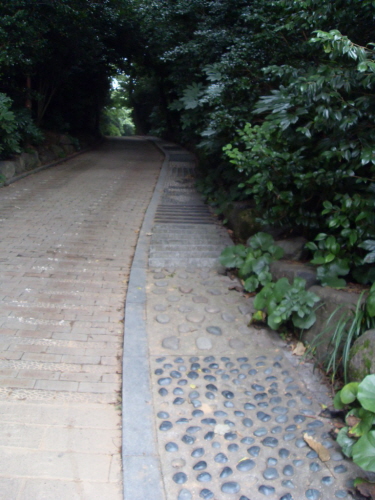
▲ 맨발공원
황금별
자, 그럼 길을 내려가자. 맨발공원이니까 맨발로 걸어보는 것도 괜찮을 거야. 우선 구두를 벗고 양말도 벗고, 하루 종일 갇혀 숨을 못 쉰 발에 신선한 공기를 쐬게 해 주자고. 자 출발할까.
(Now let's go down the street. It's good to walk without shoes because this is a 'barefoot zone.' Take off your shoes, undress your socks, release your bare feet and present your feet with some fresh air. Now, shall we start?)맨발공원은 한의학을 바탕으로 해서 만든 공원이야. 한의학은 우리나라의 전통 의학인데, 몸을 상하게 하지 않고 치료하는 놀라운 의학 기술이지. 이 한의학에 따르면, 발바닥을 자극하면 피로가 풀릴 뿐 아니라 근육도 튼튼해진대. 그러니 이 무거운 몸을 지탱하느라 지친 발에 고마워하면서 천천히 걸어가 보자고.
(The 'barefoot zone' is based on Oriental Medicine. Oriental Medicine is Korea's traditional medical knowledge, curing without straining the body. According to Oriental Medicine, stimulating the sole of the foot helps to release stress and reinforce body muscles. So let's walk slowly appreciating exhausted feet to sustain our heavy bodies.)
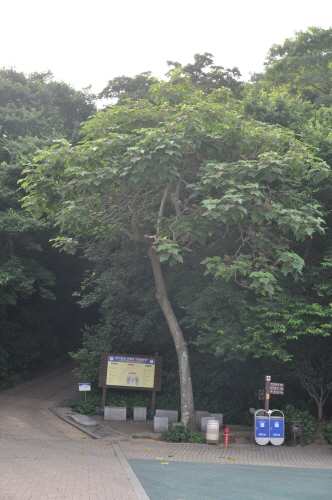
▲오동도에 남아 있는 오동나무
손지성
맨발공원의 종점에 자리 잡고 있는, 우뚝 솟은 이 나무가 무슨 나무인줄 알아? 바로 오동도의 이름을 있게 한 오동나무야. 그런데 조금 이상하지 않아? 오동나무가 많아서 오동도라는 이름이 지어진 것 같은데, 우리가 숲길을 걸어오면서 오동나무를 거의 볼 수 없었잖아.
(Do you know the tree on the end of the 'barefoot zone'? It is a paulownia (in Korea, it is called an odong tree.) which is the origin of the name 'Odongdo'. But isn't it weird? Although Odongdo was named after the paulownia, not a single paulownia could be seen alongside the road.)이 이야기를 하기 위해선, 지금부터 700년 전으로 거슬러 올라가야 해. 고려시대에 공민왕이 나라를 다스릴 때인데, 신돈이라는 신하가 있었대. 그런데 그는 고려왕조를 지키기 위해 지나칠 정도로 날카로웠어.
(To tell the story, we should trace back to 700 years ago. That was when King Gongmin was ruling Koryeo dynasty. Koryeo was declining, and a vassal named Sindon was very nervous to keep the Koryeo dynasty.)그러다 그는 오동나무가 무성한 오동도에 봉황새가 자주 드나든다는 말을 전해들은 거야. 봉황은 우리나라에서 임금을 상징하는 새인 터라, 그 새가 오동도에 드나든다니, 여기에서 새로운 임금이 나올지도 모른다는 생각에 신돈은 불안해졌어.
(One day, he heard that a phoenix came in and out of Odongdo. The phoenix was the symbol of the king and Shindon became anxious about a new king and a new dynasty.)더욱이, 오동도는 전라도에 있고, 전라도의 전(全)이라는 한자에는 임금 왕(王)이라는 글자가 들어 있어서, 신돈은 혹시 오동도에서 임금이 나오지 않을까 두려웠던 거야. 그래서 그는 오동도에 다시는 봉황이 깃들지 못하도록 오동나무를 모조리 베어 버리도록 하였대.
(Moreover, Odongdo is located in Jeollado and in Chinese letter, Jeollado's Jeon means a king. That made Shindon afraid of the new king. So he cut down all the Odong tree to drive the phoenix out of the island.)서글프지? 하지만 몇 안 남은 오동나무 가운데, 이 오동나무는 씩씩하게 잘 자라고 있으니까, 걱정 안 해도 돼.
(It's a sad story, but the paulownia among few paulownias survived and now it's in very good condition, so don't worry.)"앞으로도 사람은 자연과 어울려 잘 살 수 있어. 여수엑스포가 그것을 보여 줄 거야."("Human and Nature can be together, Yeosu Expo will show it.")
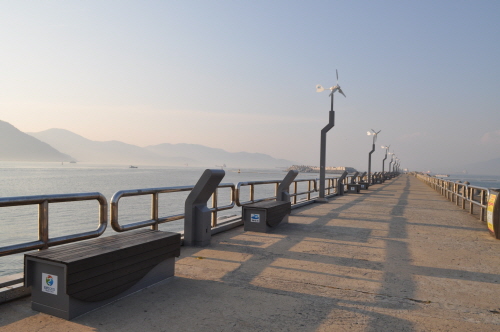
▲동방파제
손지성
자 이제 오동도 상가 뒤편으로 계속 걸어가 볼까? 그래, 여기가 동방파제야. 저 위에 빙글빙글 돌아가고 있는 바람개비들은 단순한 조형물이 아니야. 전력을 생산하는 풍력 발전기지. 이 발전기를 이용해서 밤에 이곳을 밝히지. 밤의 모습이 궁금하다고?
(Now how about going to the back of the Odong stores? Yes, we came to the east seawall. That pinwheel spinning over and over is not just a decoration. It's a small wind power plant. The electricity made here is used to light up Odongdo's night. Are you curious of the scene in the night?)
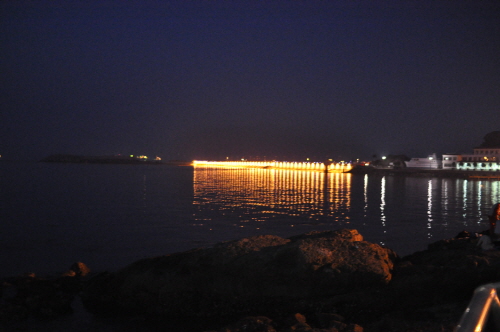
▲동방파제의 야간 조명
손지성
어때? 저기 보이는 불빛들이 환경 친화적이라 더 아름다워 보이지? 그리고 발전기 위에 나무판자를 덧붙여서 누구나 편히 쉬어 갈 수 있는 벤치를 만든 것도 참 친근하고. 자연과 기계의 만남이 이렇게 편안함을 줄 수도 있어.
(What do you think of it? The light over there looks much better after we know it's eco-friendly. And the bench made from boards seems easy and cozy for anybody. Nature and machines can be peaceful in one place.)
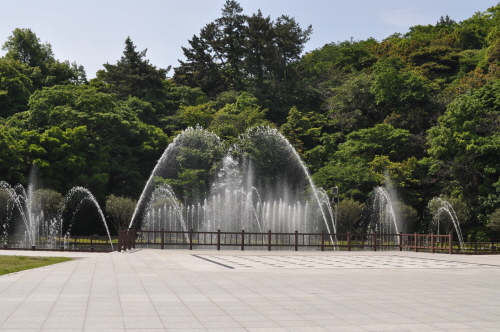
▲ 음악분수
손지성
자, 이제 다시 잔디밭으로 가볼까? 분수가 보이지? 오동도에 오면 이 음악 분수를 빼놓을 수 없지. 폭 45m, 높이 30m로 우리나라 음악분수 중 그 규모가 가장 커. 매일 오전 12시부터 오후 10시까지 시간마다 30분간 음악 쇼를 펼치는데, 아주 멋있어.
(Now, shall we go to the lawn? There's a music fountain. The music fountain is the favorite feature of Odongdo. It is 45m wide and 30m high. It's second to none music fountain in Korea. It gives a music show for 30 minutes every hour from 12 A.M. to 10 P.M. It's really nice.)분수의 주제는 2012년 여수세계박람회의 성공을 기원하는 여수 사람들의 마음을 담았어. 물안개, 오아시스, 봉황, 갈매기, 해초, 물결, 태양, 폭죽, 스크린, 등대, 가리비 등 섬의 12종 2012가지의 모양이라니까, 이것을 알고 보면 재미가 쏠쏠할 거야!
(The topic of the fountain includes Yeosu people's wishes for a successful 2012 Expo. The fountain shows various shapes, such as oasis, phoenix, seagull, seaweed, wave, sun, firework, mist, screen, lighthouse, seashell, and so on, There are total 12 types and 2012 shapes. After knowing this, it will be more interesting!)태양을 등진 채로 떨어지는 물방울도 장관이고, 가끔 만들어지는 무지개가 빠끔히 고개를 내미는 것도 정말 사랑스럽고.
(Water drops falling with the sun behind them are great spectacles and the rainbow sticking its head out is also really lovely.)
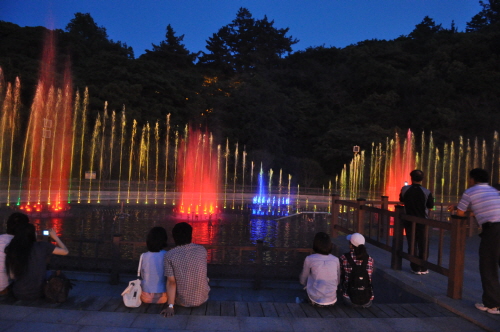
▲밤의 음악분수
손지성
밤의 음악 분수도 보고 싶다고? 그래, 어둠 속에 빛이 더욱 영롱하듯, 분수도 그래. 영롱함을 넘어 정말 황홀하거든. 이것이 오동도 음악분수의 진정한 매력인지 몰라.
(You want to see the music fountain in the night? Yes, as light in the dark is great, at night, it's more than just great - it's fascinating. This may be the real charm of Odongdo's music fountain.)어두운 밤을 비추는 색색의 조명들과 한데 어우러져 치솟는 물줄기, 그리고 정점에 다다라 부드럽게 휘어지는 곡선. 떨어지는 곡선들이 만드는 잔잔한 거품. 그 속에는 정말 미의 여신 아프로디테가 다시 태어날 것만 같지 않아?
(Colorful lighting shines through the dark night and rising a column of water, and a curve bending as it reaches at the peak. Gentle bubbles are made by falling curves. It seems that Aphrodite, the goddess of beauty, could be reborn in the music fountain, couldn't it?)
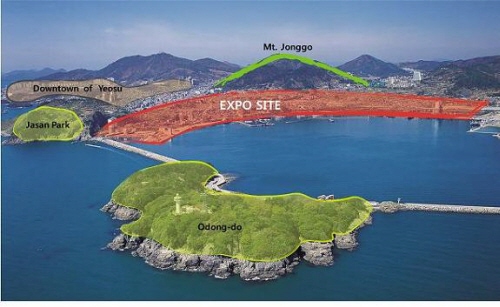
▲오동도 앞에 펼쳐진 박람회장 부지
2012여수박람회조직위원회
2012년에 여수에서 열리는 엑스포의 중심지가 바로 오동도 일대야. 저기 앞을 봐. 우리가 오늘 출발한 자산공원 옆으로 박람회장 부지가 보이지.
(Odongdo will be the center area of the Expo in 2012. Look forward. We can see the exhibition site where we started our travel today.)박람회장 부지 안에는 산업 시대의 유산이 여기저기 있어. 콘크리트 사일로가 그 대표적인 예지. 그런데 우리는 이것들을 철거하지 않고, 세계박람회의 상징물이자, 박람회 이후 문화관광의 아이콘으로 활용할 계획이야.
(There's some remains of Industrial Era in the fairground, such as a concrete silo. Instead of tearing these hideous things down, people decided to reuse it as an icon of cultural tourism.)여수세계박람회를 '지속 가능한 엑스포'라고 부르는 까닭을 알겠어? 가능하면 아무것도 상하지 않게, 아무것도 다치지 않게, 환경 친화적으로 우리나라 사람들은 엑스포를 준비하고 있어.
(This is why we call Yeosu Expo 'Sustainable Expo'. They do their best not to harm and waste anything and prepare for the Expo in eco-friendly way.)이번 여행에서 느낀 것처럼, 우리 여수 사람들은 '괴테'처럼 오동도라는 꽃을 '시들지 않게' 인간에게 옮겨 심었어. 이러한 마음가짐으로 우리나라 사람들 모두 엑스포를 준비하고 있으니, 기대해도 돼. 어서 2012년이 되었으면 좋겠다고? 그래, 우리도 마찬가지 심정이야.
(As we felt during the travel, citizens of Yeosu took Goethe's way and tried to transplant a flower named Odongdo to be near humans 'without its wilting'. With this attitude, all Koreans are preparing for the Expo, so you can look forward to our Expo. Do you want 2012 to come quickly? Yes, we do, too.)아쉽지만 오늘 여행은 여기서 마쳐야겠어. 하지만 다음 여행에는 '더욱 아름다운 여수'를 보여 줄 계획이야. 그러니 너무 섭섭해 하지 마. 내일 태양은 더욱 찬란하게 떠오른다고 하잖아. 그럼 다음 여행까지 안녕!
(Sadly, this is end of today's trip. But on the next journey, we are planning to show you 'More beautiful Yeosu'! So don't feel sorry too much. After all, tomorrow is another day! See you next time. Bye!)(기사 작성 : 동아리 <사랑해여수>의 황금별, 이지성, 손지성, 안유정, 이혜인 기자. 지도 교사 : 박용성)
(News written by the group of 'I Love Yeosu' : Hwang Geumbyeol, Yi Jiseong, Son Jiseong, An Yujeong, Lee Hyein reporter. Guidance teacher : Park Yongseong) 덧붙이는 글 | 우리 아이들과 봄소풍을 갔던, 4월 19일부터 준비한 기사입니다. 이번 여행기에는 <시>를 결합하였는데, 다음 여행기에는 <우리 그림(주로 민화)>을 결합하기로 하였습니다. 여행을 하면서 <여수>는 그냥 <여수>가 아니라, <우리 고향>이자 <우리 인류가 돌아가고 싶은 고향>이 되었으면 하는 생각이 간절해졌습니다.
저작권자(c) 오마이뉴스(시민기자), 무단 전재 및 재배포 금지
오탈자 신고
기사를 스크랩했습니다.
스크랩 페이지로 이동 하시겠습니까?
연도별 콘텐츠 보기